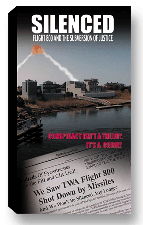Climategate, TWA Flight 800, and Andy Revkin
![]()

About Silenced: Flight 800
and the Subversion
of Justice (DVD) -
-Buy the Silenced DVD-
© Jack Cashill
December 10, 2009 - WorldNetDaily.com
The respective investigations into the 1996 crash of TWA Flight 800 and into climate change have something very specific in common beyond the corruption of results for political ends.
That is the role of the New York Times, in particular Times’ environment reporter Andrew Revkin, in enabling that corruption.
In both cases, Revkin and the Times would pick sides in a scientific controversy, cozy up to the side picked, champion its counterfeit data, and marginalize the opposition.
As to “Climategate,” the emails hacked from the University of East Anglia's Climatic Research Unit show Revkin very much an active participant in the information flow.
What they reveal is an insecure reporter working hard to ingratiate himself with the world’s most influential global warming advocates.
In one relatively benign email to “dear all,” for instance, Revkin addresses a specific “bone of contention with a lot of the anti-greenhouse-limits folks.”
Although the issue is too dense to explore here, Revkin concludes his email with his trademark sycophancy: “hoping to show a bit of how that works. thanks for any insights. and i encourage you to comment and provide links etc with the current post to add context etc.”
Incredibly, after Climategate broke, the Times’ editors allowed Revkin to continue covering the scandal even though he himself was central to the story.
His subsequent reporting has drawn intense heat from critics, especially since his instinct has been to cover for his friends.
"The evidence pointing to a growing human contribution to global warming is so widely accepted that the hacked material is unlikely to erode the overall argument," Revkin wrote at the scandal’s outset.
Under pressure, Revkin has since begun to raise at least a few questions about the scandal and the science behind it.
His friends, however, have no tolerance even for Revkin’s most gentle questions. And they know his weakness: the reporter’s fear of being cut off from his sources.
Revkin’s particular vulnerability came to light in a recent warning that the University of Illinois’ Michael Schlesinger e-mailed to Revkin and unthinkingly copied to, among others, the American Enterprise Institute’s Steven Hayward.
“The vibe that I am getting from here, there and everywhere,” wrote Schlessinger to Revkin, “is that your reportage is very worrisome to most climate scientists.”
“Of course, your blog is your blog,” Schlessinger continued, “But, I sense that you are about to experience the 'Big Cutoff' from those of us who believe we can no longer trust you, me included.”
If Revkin’s reporting on the TWA Flight 800 investigation in 1996-97 is any indication, Schlessinger need not fear that Revkin will risk being cut off.
In the way of background, On July 17, 1996, TWA Flight 800 exploded only 12 minutes out of JFK along the south shore of Long Island. Revkin was one of two or three lead reporters on the story.
To control the information flow, the FBI shared all of its new revelations only with the Times’ reporters. This strategy forced all the other media to look to the Times, but it also increased the dependence of Revkin and his colleagues on the FBI.
The reporting during the first month after the crash was cautious but honest. On August 14, the Times’ Don Van Natta would report that the center fuel tank had caught fire well after the plane had been blown apart, “a finding that deals a serious blow to the already remote possibility that a mechanical accident caused the crash.”
Van Natta’s conclusion had to have sent shock waves through the White House: “Now that investigators say they think the center fuel tank did not explode, they say the only good explanations remaining are that a bomb or a missile brought down the plane.”
Likely under pressure, the FBI immediately shifted its story line, and Revkin got the call to deliver its message. On August 17, he wrote the Times’ first article on the crash’s many eyewitnesses.
Out of the hundreds available, Revkin interviewed just one. The FBI had served up this particular witness because he had seen only the tail end of the drama. What he saw, Revkin wrote, "substantially weakened support for the idea that a missile downed the plane."
Revkin tracked fully with the FBI's spin, claiming that the witness’s account of a quick white flash well before the large fireball has "bolstered the idea that a bomb, and not an exploding fuel tank, triggered the disintegration of the airplane."
By this time, no fewer than 270 eyewitnesses had given formal reports to the FBI describing an object rising off the surface and striking the doomed plane.
Astonishingly, Revkin and his colleagues would not report a single interview with any one of them at any time.
For all its misdirection, the FBI seems to have been struggling against the White House throughout August. On Aug. 23, the Times broke a headline story with the FBI’s help, top right: "Prime Evidence Found That Device Exploded in Cabin of Flight 800."
This article stole the thunder from Clinton's election-driven approval of welfare reform in that same day's paper and threatened to undermine the peace and prosperity message of next week's Democratic convention.
The terrorism message could not stand. The Clinton administration decided to manufacture a cause for the crash, and when it did, the reliable Revkin was given the nod once more.
On September 19, the Times published his bellwether article, “Fuel Tank Crucial To All Crash Theories.” Flushing all previous evidence down the memory hole, the NTSB was now planning “tests intended to show that the explosion could have been caused by a mechanical failure alone.”
All such tests would prove fruitless, but by November 1996, the Times would be dismissing explanations other than a spontaneously exploding fuel tank as “conspiracy theories.”
More than a year later, it was Revkin who got the assignment to rap up the Times’ reporting on this fully corrupted investigation.
The headline of his November 14, 1997 article said as much about the reporting as it did the investigation, “A Bold Start Stretched To 16 Fruitless Months.”
The “respectable” conservative media bought into the Times’ misreporting on TWA Flight 800. Here is hoping that Climategate will shock them out of their complacency.
Special Note:
Jack Cashill and James Sanders' First Strike: TWA Flight 800 and the Attack on America is now available. First Strike explains how a determined corps of ordinary citizens worked to reveal the compromise and corruption that tainted the federal investigation. With an impressive array of facts, Jack Cashill and James Sanders show the relationship between events in July 1996 and September 2001 and proclaim how and why the American government has attempted to cover up the truth.
- Buy the Mega Fix DVD -


